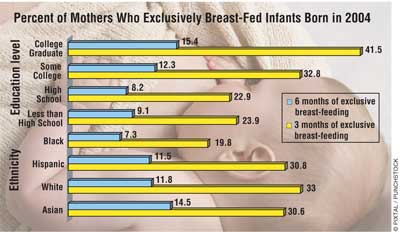US Pharm.
2007;32(9):8.
Research
has proven that breast milk is more beneficial to a newborn than formula. One
of the goals of Healthy People 2010, a national health promotion and
disease prevention initiative, is to increase the percentage of American women
who breast-feed their infants through ages 3 months, 6 months, and 12 months
to 75%, 50%, and 25%, respectively, by the year 2010.
A recent article in
Morbidity and Mortality Weekly Report (MMWR) revealed findings from a CDC
analysis of data from the National Immunization Survey. The survey findings
indicated that more women initiated breast-feeding (through age 3 months) in
2004 (73.8%) than in 2000 (70.9%), nearly reaching the national objective of
75%. Likewise, breast-feeding rates through ages 6 months and 12 months were
41.5% and 20.9%, respectively, in 2004, compared with 34.2% and 15.7%,
respectively, in 2000.

In 2007, the Healthy People
2010 objectives were updated to include goals for exclusive
breast-feeding: to increase the percentage of mothers who exclusively
breast-feed their infants through age 3 months to 60% and through age 6 months
to 25%. Exclusive breast-feeding is defined as feeding an infant only
breast milk and no other liquids or solids, except for drops or syrups
containing vitamins or medicines. The American Academy of Pediatrics and other
health organizations recommend that mothers exclusively breast-feed their
infants for the first six months of life, with continuation of breast-feeding
through age 12 months and beyond while other foods are introduced.
According to the MMWR
report, rates for exclusive breast-feeding were far below the national
objectives. Among infants born in 2004, rates for exclusive breast-feeding
through ages 3 months and 6 months were 30.5% and 11.3%, respectively.
Disparities were observed in
rates of exclusive breast-feeding among infants born in 2004. Rates of
exclusive breast-feeding through age 3 months were lowest among black infants
(19.8%) and infants of mothers younger than 20 (16.8%). Rates were also low
among infants of mothers who had a high school education or less (22.9% and
23.9%, respectively), were unmarried (18.8%), resided in rural areas (23.9%),
and were poor (23.9%).
According to the authors of
the MMWR report, "Lower rates of breast-feeding among black women have
been attributed to several factors, such as economic pressures to return to
work environments that do not support breast-feeding, lack of breast-feeding
education and supportive social networks, aggressive marketing by formula
manufacturers, and cultural environments that do not value breast-feeding or
promote positive images of breast-feeding women."
To comment on this article,
contact editor@uspharmacist.com.





